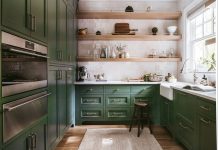Photos by Spacecrafting


“Walking through our house is an experience,” says the owner of this contemporary home on the shores of Lake Minnetonka’s Robinson Bay. “Every detail is intentional.” Completed last fall, the modestly scaled house oozes quality through its sophisticated design and discernible—but not conspicuous—luxury. The owners, a couple with four adult children, didn’t need or want a giant house with rooms they would rarely use. They wanted the right space with openness and flow for entertaining, room for the kids to stay when they visit, and plenty of clean walls to display and enjoy their collection of early 20th-century American art. Making the property as green as possible was the icing on the cake.
They worked with longtime friend and trusted collaborator Gary Aülik of Edina-based Aülik Design Build, who first helped them find the one-of-a-kind property: a private, secluded lot with a dated house that otherwise won the real estate trifecta of west-facing and flat with ample sandy shoreline. Aülik’s team tore down the house and spent a year planning what would go in its place—studying the site and deciding what sort of space and features would best serve the clients. “Gary is a savant when it comes to design,” says the homeowner. “We gave him and Charlie [the architect] a lot of creative license.”

The unique design is the repetition of a simple form (which Aülik describes as the “house” shape people may have drawn as a child) connected by contemporary glass masses. The exterior is clad in dolomitic limestone sourced from a quarry near Milwaukee, Wisconsin, with each stone hand-picked for the proper color and soft, weathered edges—a process that took six months. “The overall effect suggests a series of older, more historic buildings that were modified and linked together,” says Aülik.

The stone carries into the interior, strengthening the indoor/outdoor connection and grounding the modern furnishings. Material respect is a theme throughout the house, including the random width oak floors that were hand-scraped to create a patina—one the owners’ dogs have already enhanced. Forgoing sheetrock in favor of more labor-intensive plaster walls and ceilings adds subtle texture and depth. Clearly, shortcuts were not a part of this home’s vocabulary.
In collaboration with Redpath Constable Interior Design, each room was designed with purpose and customized to the homeowners’ lifestyle, right down to the built-in couch that’s perfect for afternoon naps in the office. A covered porch with a wood-burning fireplace is a favorite spot and prime example of how the house blurs the line of indoors and out. With interior doors that open the length of the room and vinyl sun and screen shades that are automated, regulate temperature, and keep bugs at bay, the room is primed to enjoy the lake view in any season, at any time of day. The sleek, modern kitchen from Italian maker Valcucine looks like it could be in an art gallery but is actually an eco-friendly, hardworking unit. Additionally, the homeowners remodeled a carriage house already on the property to resemble the main home.


The home’s bespoke aesthetics are enough to earn it a spot on boaters’ house-gawking cruises. But in this case, looks are just the tip of the iceberg. The homeowners also gave Aülik the green light, so to speak, to build the house to meet the Department of Energy’s Net Zero Energy program requirements. This meant spending copious time on unsexy stuff—like specific ductwork, insulation, water pumps, windows, and building methods that maximize energy efficiency. Solar panels on the roof provide electricity (often in excess of what they require, enabling the homeowners to sell power back to the grid). Architect Charlie Peterson says, “We were excited that our clients were willing to take this step and support us in our efforts to meet these requirements and be on the leading edge of home design and construction.”
The sophisticated lighting system is on another level, featuring tunable LED fixtures that adjust the color, temperature, and intensity of light depending on the time of day, time of year, and weather. “It further blurs the line between inside and out. If you have all the lights on inside the house, you’d swear you were outside,” Aülik enthuses. Most of the lighting is placed in channels around the ceiling, and there are no pendants to obstruct sightlines, so the lighting is perceived more than it is seen. The ceiling is polished to reflect light, both natural and electric, which bounces off it in a way that mimics water.

Impressively, the new house and landscaping reduced hardcover on the property to the tune of several thousand square feet. Alongside Edelweiss Design, Aülik’s team achieved part of this through more environmentally friendly landscaping like a permeable surface driveway and two rain gardens. But the new house is actually smaller than its predecessor’s footprint, following a principle Aülik boils down to this: Build no more home than you need. He states, “A smaller home with higher quality materials will provide energy savings, lower maintenance costs, and lower property taxes.”
A Gingko tree he sourced (and personally drove to Illinois to select) in the front of the house may best capture the spirit of this project. Often called living fossils, Gingkos are considered symbols of longevity and have been around for millions of years. Looking at it and the stone house that lies beyond, one senses a certain kinship. Aülik says, “This is a house for today and generations to come.”






















